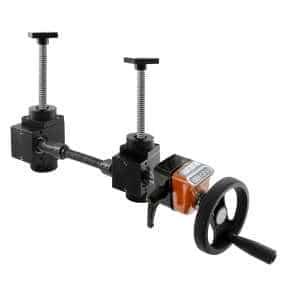Screw jacks are the ubiquitous powerhouses of linear motion, but their magic lies in the intricate interplay of their components. Among these, the trapezoidal lifting screw reigns supreme, acting as the core element responsible for converting rotation into powerful linear force. Let’s delve into the world of trapezoidal lifting screws and explore their role in screw jack operation:
The Anatomy of a Trapezoidal Screw:
- Threaded Design: The defining feature of this screw is its thread profile. Unlike a standard bolt thread with a triangular shape, a trapezoidal screw has a thread profile resembling a trapezoid. This distinct shape offers several advantages.
- Flat Top and Bottom: The flat top and bottom surfaces of the trapezoidal thread provide a larger contact area between the screw and the mating nut. This increased surface area translates into higher load-bearing capacity compared to screws with a triangular thread profile.
- Lead Angle: The lead angle refers to the angle between the thread and the axis of the screw. In screw jacks, the lead angle is typically high, allowing for a larger linear movement of the nut per revolution of the screw.
The Power of Linear Motion:
- Translating Rotation: Within a jack screw, the trapezoidal lifting screw is often fixed in place. A nut containing the worm gear mechanism rotates around the screw. As the nut rotates and its teeth engage with the screw’s threads, the nut travels linearly along the axis of the screw. This linear motion is what allows the screw jack to lift or push objects.
Advantages of Trapezoidal Threads:
- High Load Capacity: The larger contact area between the screw and nut enables trapezoidal threads to handle significant loads, making them ideal for screw jacks used in lifting and pushing applications.
- Efficiency: The trapezoidal thread profile offers a good balance between efficiency and load-bearing capacity. While some friction is present, it’s generally lower compared to other thread profiles like acme threads.
- Self-Locking (Optional): In some screw jack designs, the specific geometry of the trapezoidal thread can create a self-locking effect. This prevents the nut from moving downwards unless the screw is rotated, enhancing safety in certain applications.
Beyond the Basics:
- Material Selection: Trapezoidal lifting screws are typically manufactured from high-strength steel or stainless steel to ensure durability and handle demanding loads.
- Surface Treatment: In some cases, the screw might undergo surface treatments like hardening or coating to improve wear resistance and corrosion protection.
- Lead Screw Options: Screw jacks might offer different lead screw options with varying lead angles. Choosing the right lead screw depends on the desired balance between lifting speed and force requirements.
Conclusion:
The seemingly simple trapezoidal lifting screw plays a starring role in the power and functionality of screw jacks. Its unique thread profile, high load capacity, and potential for self-locking make it the workhorse within, transforming rotary motion into the powerful linear actuation that drives countless industrial applications.








